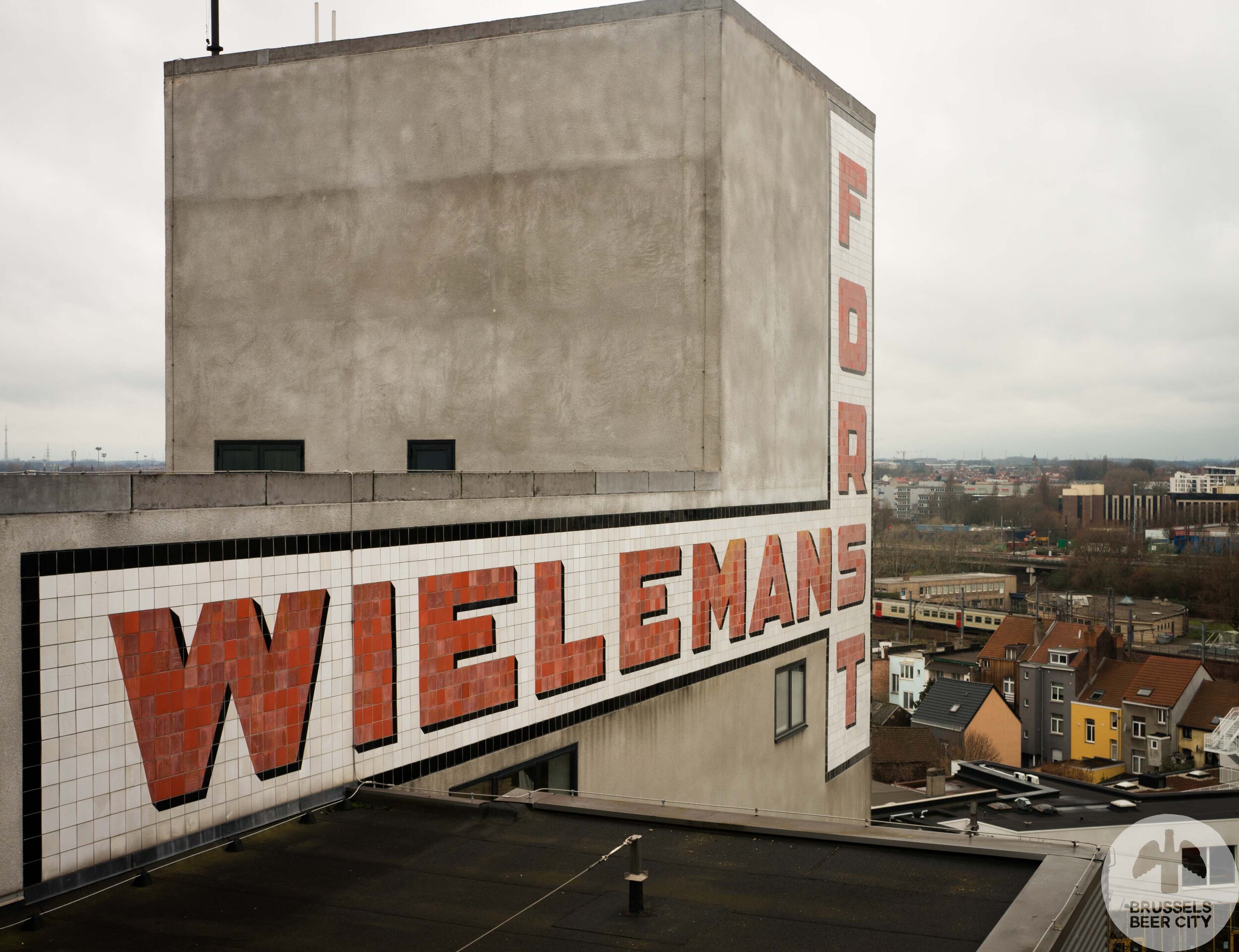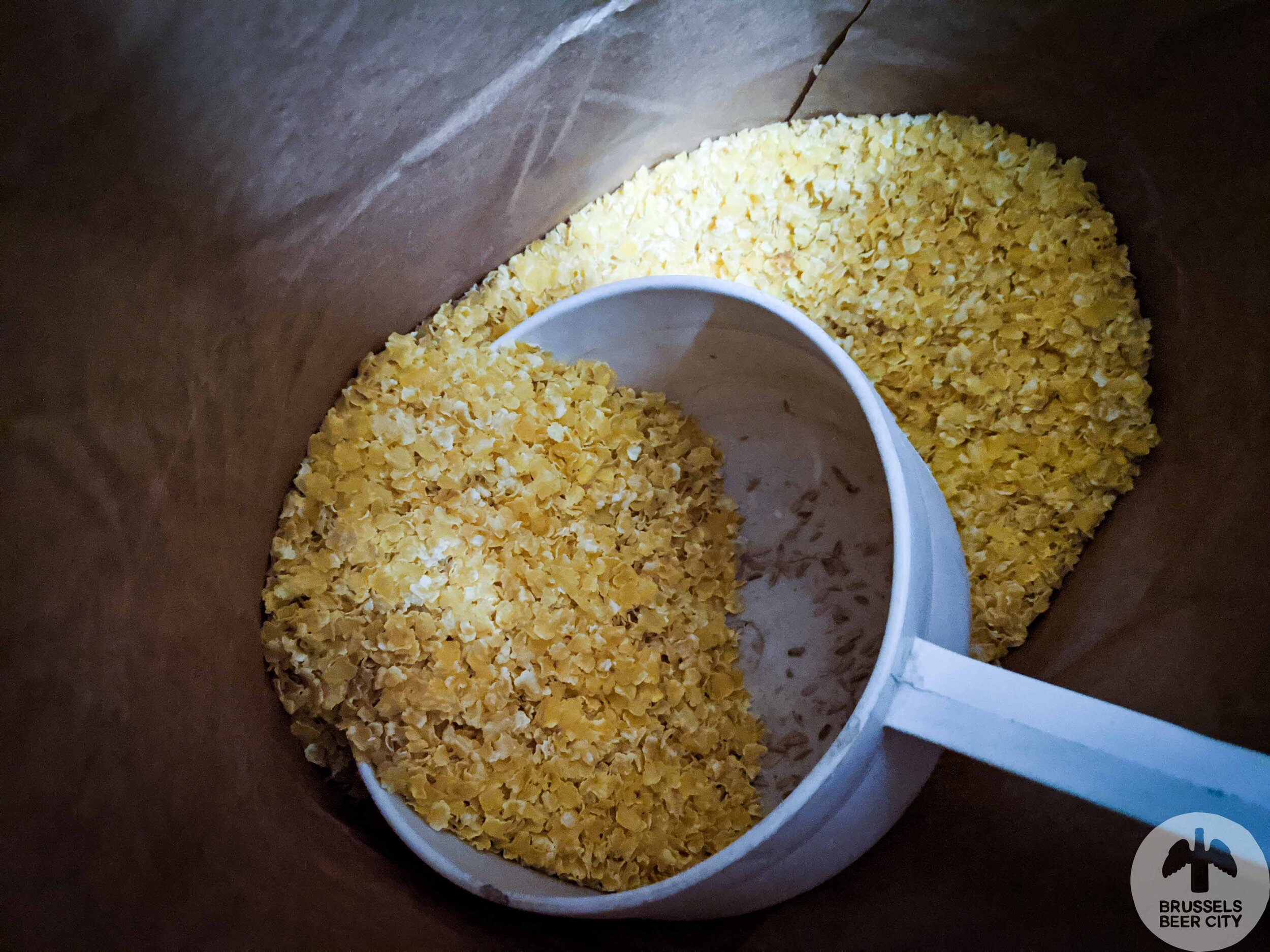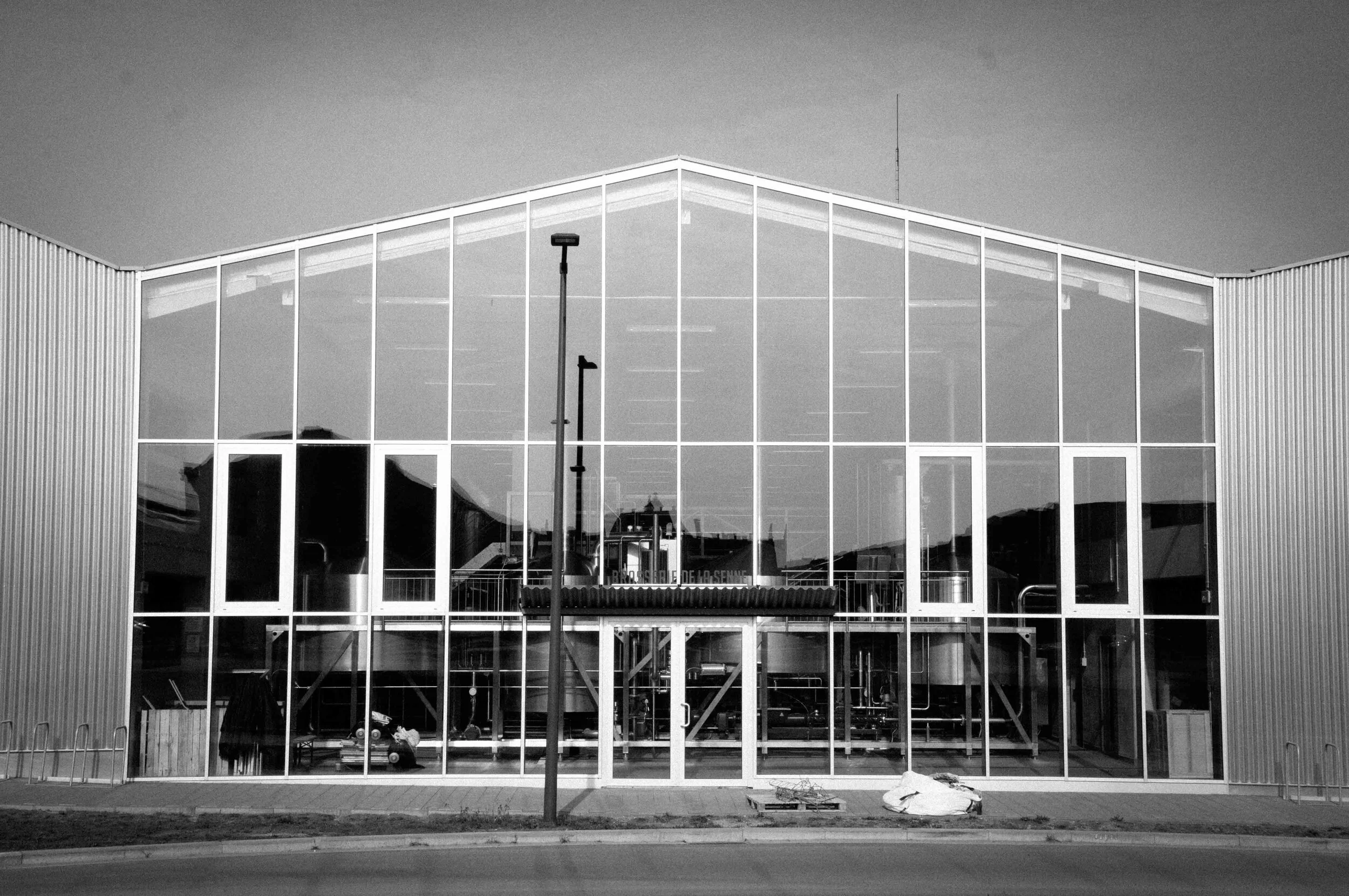Brewing up a skite // SCTCH 1920 and the rebirth of the Brussels Scotch Ale
Skite [/skaɪt/]: (Scotland, slang) verb. To drink a large amount of alcohol
It was around the sixth weighty bag of Pale Ale malt when I started wondering what I was doing. Writing about beer is just that - writing. Sitting at my desk into the small hours, mashing the keys on my laptop until words cohere. It’s a profession precision engineered to avoid physical exertion. Let alone hauling 275 kilos of English barley malt around Brussels Beer Project’s (BBP) brewery on a bleary-eyed Autumn Monday morning.
But it was my own fault. While finishing Brussels Beer City: Stories from Brussels’ Brewing Past, I shared a beer with BBP brewer Sam Fleet. Sam is from the Black Country in England, raised on cask Bitters and Milds, and has a keen interest in brewing history. We thought it might be fun to collaborate in the future on recreating something old school from our adopted homeland, maybe with a little added English influence. Some time later I finished the book, and remembered my conversation with Sam. Virtually all of the breweries featured in the book have long-since disappeared, and as much as I can try to bring these breweries to life in prose something visceral is lacking - the taste, texture and sensory experience of the beers that were the very reason for their existence. And was that even something we could recreate in some ersatz replica brewed in Brussels anno 2020?
It was this thought that ultimately led me to that August morning, hauling bags of grain across a wet brewery floor, sweatily plunging a brewer’s mash paddle into a steaming mash of barley and corn grits, as together Sam and I attempted to recreate a style wildly popular in the Brussels of the 1920s - the Scotch Ale.
Leaving Lambic to one side
Why a Scotch Ale? Why not something indigenous? Brussels is after all home to one of the most rhapsodised - not to mention idiosyncratic - methods of brewing in Lambic and Geuze, a tradition deeply embedded in the city’s culture and folklore. Lambic brewing was itself close to oblivion in the late 20th century - a victim of the twin motors of changing tastes and the rise of industrial brewing that transformed Brussels’ brewing landscape. But making a Lambic is to misinterpret our mission, never mind the complexities both brewing and political that would have come with it. And Lambic is experiencing unprecedented success in the last 20 years as its reputation and international interest has grown exponentially. While Brussels continues to house only one Lambic brewery in its boundaries in Brasserie Cantillon, the tradition needs neither resuscitation nor rediscovery.
“...the celebrated beers Pale Ale, Stout Worthington, as well as the Scotch Ale [and] Christmas Ale Mac-Ewan [sic]”
Pre-modern Brussels was home to exotic-sounding beers named for their colour or their price - braspfennig, roet, brune. But, outside of medieval experts, these beers are lost to history. There is little to no chance of recreating them with modern brewing ingredients, even if traditional practices could be replicated.
Instead, I wanted to take direct inspiration from the period most intensively covered in the book: the emergence of industrial brewing Brussels from the late 1880s through to World War II. This was a period when brewing transformed from an artisanal family business centred in medieval Brussels, into one of gleaming beer factories in the suburbs run on hyper-modern equipment. And in these breweries it was not local beer styles that were driving growth but foreign beers that had captured the imagination of local drinkers - Bohemian pilsners and Bavarian lager beers first, then a flood of Pale Ales and Stouts from England and Scotland.
“The best English beers”
It was British beer that dominated immediately after 1918 and Armistice as Belgium attempted to rebuild. It was a period when, for example, on Christmas Day 1919 a Brussels local could make their way to the Royal Greenwich on the Boulevard du Jardin Botanique (“one of the richest establishments of the capital”), where the owner - a M. Romain - was ready to dispense in modern surroundings “the celebrated beers Pale Ale, Stout Worthington, as well as the Scotch Ale [and] Christmas Ale Mac-Ewan [sic])”. It was a time when the newspapers quite comfortably and unpatriotically described these beers as “the best English beers”. Scotch Ale was - despite what the journalists might have written - a beer style that emerged in Scotland, with a pretty fluid identity.
Throughout the 19th century it would have been a top fermented, of varying colour (but still quite pale) and varying alcohol content, according to beer historian Ron Pattinson. “If you look at Scotch Ale in the 19th century, it would have been pretty pale,” Pattinson says, “and the early descriptions of Edinburgh ale or Scotch Ale going on about its very pale colour.” The style darkened as it evolved, and the Scotch Ales that made their way to Brussels and bars like the Royal Greenwich could have been on the paler or darker spectrum of the overall style. Scotch Ale was becoming a darker, less bitter, and more sweet beer. “That was the trend in the 20th century, for hopping to go right down,” Pattinson says. “It was different in the 19th century. People seemed to have gotten a taste for sweeter beers in Scotland….Obviously people expected most of their beers to be quite sweet.”
Drinkers also expected their Scotch Ales to be strong - or at least Belgian drinkers did. And as Guinness produced a special, higher-ABV version of their Stout for Belgium, so did Scottish brewers with their Scotch Ales. “I’m sure a lot of beers brewed in Scotland were brewed for the Belgian market, and of course after WWII you see the beers they were selling in Scotland were weaker than the ones brewed in Belgium,” says Pattinson.
“Very fine, incomparable” Scotch Ale
And in time, given the popularity of beers from Whitbread, Barclay Perkins, McEwans and Usher’s, - between 1880 and 1910, imported beer grew from 24,000 hectolitres to 237,000 - local breweries responded with domestic alternatives. Wielemans-Ceuppens of Vorst in Brussels were advertising their Crowned Trees Stout and Crowned Trees Scotch as early as 1924. Those two beers were a roaring success, and propelled Wielemans to build a startlingly modern Art Deco headquarters in 1933, complete with its own rail connection and one of the largest breweries in Europe. English brewers remained popular throughout the 1920s and 1930s, but slowly it was the local brewers who gained the upper hand; Wielemans’ now-abbreviated CTS Stout and Scotch were described respectively in the brewery’s own ad copy in 1934 as having “triumphed over similar foreign beers” and “very fine, incomparable…it earns us daily congratulations from many connoisseurs.”
By February 1940, on the eve of German invasion, journalists lauded Wielemans for “unprecedented success” in supplanting the foreign interlopers. Wielemans eventually discontinued the CTS Stout, but Scotch CTS remained a part of its core range right until the brewery’s demise in November 1988.
By the post-WWII period, the template for the Belgian Scotch Ale was set in the minds of drinkers here: strong, sweet, and dark but not roasted. A beer possessing the name Scotch CTS and meeting these criteria is still brewed today in Leuven by Artois, but how closely it approximates the beer first brewed in the 1920s is impossible to judge, even if we can have our suspicions. It does, however, possess the dubious honour of being the only beer brewed by Brussels’ long-vanished industrial giants that has survived into 2020.
And it is a beer primed for contemporary rehabilitation.
Treacly-sweet and good dose of alcohol
Before we called up Ron Pattinson for a recipe from his extensive archive of British brewing, Sam and I organised a small tasting session (accompanied by Pattinson’s to survey the state of Belgian Scotch Ales in 2020. It’s not a popular style, but we managed to source a broad spectrum from local and artisanal to those of the country’s big industrial breweries. En Stoemenlings were the first Brussels brewery to attempt the style, their Billy McLeod leaning towards a more smoky, peated interpretation. Brasserie Silly are still producing their Scotch, 102 years after British soldier Jack Payne requested they brew something that tasted of home. True to their Anglophone roots, Anthony Martin’s Gordon Scotch Ale (thistle glass and all) is probably the most recognisable holdover of the style, and alongside Watneys Scotch Ale (brewed by Heineken subsidiary Alken Maes) probably most representative of the modern-day Belgian Scotch Ale - treacly-sweet, with little hop character (aroma or bitterness), a deep burgundy hue, and a good dose of alcohol.
And it was to Pattinson that we turned when it came to considering what kind of Scotch Ale the brewers at Wielemans-Ceuppens might have experienced at the height of the beer’s popularity in the 1920s. Several potential recipes were suggested until we settled on a 1928 Old Scotch Ale from Edinburgh’s Thomas Usher. A serendipitous choice, as it turns out, because in the 1920s Usher’s had a depot in Brussels where they wined and dined businesses and journalists with their Pale Ales, Stouts, Scotch, and a Christmas Ale described as being of a “mellow and perfect taste”.
“Scottish breweries…were crazy for colouring up their beers”
The recipe was, according to Pattinson, “typical” of the kind of Scotch Ales British breweries were shipping to Belgium. The malt bill was made up of 78% Maris Otter pale malt, 11% flaked maize and 10% “No. 2 invert sugar” (sucrose converted into glucose and fructose, and widely used in UK brewing as a source of fermentable sugars). It was then hopped with Goldings, a traditional English hop varietal, before fermentation with a strain of Edinburgh ale yeast to produce a 7.81% light copper/auburn-coloured, and reasonably bitter beer. And it was that colour that first caught Sam’s attention: “I thought CTS Scotch was a dark beer!???”
But, as Pattinson explains, the colour of Scotch Ales Sam would be familiar with is misleading. “Scottish breweries…were crazy for colouring up their beers,” he says. “They’d have it [looking] ‘as brewed’ all the way to near-black, depending on where it was going to be sold…This was all done with caramel at racking time. It’s a really typical Scottish thing to colour beers with caramel.” The underlying beer was usually the same standard Pale Ale recipe, and the colour correction was sometimes for flavour (how much caramel a brewer used would have some impact on the end result), sometimes for consistency of desired hue, and - as Ron says - sometimes to do with the expectations of local drinkers in a particular place as to the look of a “proper” Scotch Ale.
Once Sam reconciled the Scotch Ale of his imagination and the Scotch Ale he was going to brew, he got to work adapting the recipe to BBP’s brewhouse. The malt - floor-malted Fawcett’s Maris Otter Pale Ale malt - and flaked maize (which looked to me, a novice, like slightly lighter Kellogg’s Cornflakes) were simple enough, though the 800 litres of beer we planned to brew required a quantity of grain (275kg) greater even than that used by Sam and his colleagues for a typical imperial Stout. For want of invert sugar, and to anchor the recipe locally, we used honey sourced from a Brussels apiary.
The hop profile also diverged. Instead of traditional English Goldings (or Fuggles, another classic English hop), Sam plumped for Groene Bel, a heritage Belgian hop variety that was widely grown around Aalst to the west of Brussels in the early 20th century. Groene Bel had largely disappeared by the 1950s as brewers instead favoured German and Czech hop varieties, and was only rediscovered by chance in 2012 when students from Aalst discovered a sample of it in the library of the The Slovenian Institute For Hop. Alongside the Groene Bel Sam chose Progress also Belgian-grown (by hop growers ‘t Hoppecruyt), but a British breed grown as a replacement for Fuggles. He also added an unorthodox handful of Czech Saaz to help build a more complex bitterness.
“[A] bitter, boozy, warming, with notes of a ripe orchard. Drinkable, comforting, and very dangerous,” he says. “For those familiar with Belgium’s brewing traditions, it might make you think twice about what you know”
The selected yeast strain was truer to the original Usher’s Scotch Ale recipe. Sam selected the White Labs Edinburgh Ale yeast - a yeast with low attenuation (not going to consume all the sugars), a high alcohol tolerance, and likely to impart pear/melon flavours to the final beer. This is a yeast which supposedly isolated from Scottish brewery McEwans, a brewery which was not only present in Brussels with their Scotch Ales, but whose yeast Michael Jackson reported as having been used - in an act of industrial espionage - to make the original version of Duvel.
Alongside the ingredients were a number of anachronistic brewing processes Sam had to navigate. The recipe called for 10 sparges, essentially washing out as much sugar as possible from the mash, and a longish boil (105 minutes, which we reduced to 90). Sam then added a couple of tweaks of his own. First, he undertook a pre-mash decoction to give more complexity to the body of the beer (modern-day malt is more “modified” - basically, more efficient at converting starch to sugars - than the malt that Usher’s would have been using in their Scotch). He then added the Saaz hops to the mash in an effort to add a little more complexity to the bitter, but otherwise the beer that was siphoned into the steel fermentation tanks at the end of the brew day was as faithful a replica of a 1928 Scotch Ale as we could approximate.
A couple of weeks of fermentation and lagering, followed by two weeks of bottle conditioning in the brewery’s warm room, and SCTCH 1920 was ready. I’ll leave it to Sam to describe the results: “[A] bitter, boozy, warming, with notes of a ripe orchard. Drinkable, comforting, and very dangerous,” he says. “For those familiar with Belgium’s brewing traditions, it might make you think twice about what you know.”
All through this process, the words of Yvan De Baets - co-founder of Brasserie de la Senne - about the impossibility of recreating dead beers were a constant refrain. “I understand the fantasy, but that’s the real fantasy,” De Baets says in the book. “You need the whole brewery, and the brewers. I wish it was the case, but sadly it’s not.” It’s a view Sam shares: “Personally, I don’t think you can ever recreate an old beer exactly, but you can definitely recreate the spirit, and I believe we’ve done that with our interpretation of a Scotch Ale.” Ingredients, processes, knowledge, and even equipment have all changed considerably since 1928. Not to mention that beyond what’s written down on paper we had no first person accounts of what an Usher’s Scotch Ale would have looked or tasted like.
But as Sam says, faithful recreation was not really our goal. Brewing an approximation of a beer that had long since disappeared and whose successors have for decades been out of favour with contemporary drinkers was, to try and understand what was it about these beers that first captured the attention and the palates of early-20th century Brussels.
In doing so, we confronted some of our preconceived notions about the beers of that time, as well as reminding us of the deep interconnectedness of Belgian and British brewing - then and now. Belgium’s regional tourism boards might have you believe Belgian beer materialised as if spontaneously, immaculately, from the sodden land of Flanders and Wallonia. But, as anyone versed in Belgian brewing will tell you - pull at that thread and immediately a brewing history of influence and exchange of ingredients, styles, and techniques unravels - from neighbours, conquering and occupying forces, and trading partners. Like Britain.
Interconnectedness across the Channel
Our Scotch Ale is case in point. Before it was bottled and sent for conditioning, we gathered at the brewery for a quick taste to see how it was progressing. Thinking where SCTCH 1920 might fit on the beer style spectrum, more than one of us remarked upon its similarities with another, ur-Belgian beer. Yes it was probably more bitter, and maybe it was lacking the characteristic phenolic, banana-like aromas. But in its light golden shine, translucence, and warming alcoholic sweetness this Scotch Ale reminded us of another beer that emerged for the first time during Belgium’s interwar golden age: the Tripel.
“Personally, I don’t think you can ever recreate an old beer exactly, but you can definitely recreate the spirit, and I believe we’ve done that with our interpretation of a Scotch Ale”
As well as birthing a rake of Belgian imitators, the influx of Pale Ales from England and Pilsners from Germany stimulated Belgian brewers to create not just local facsimiles of foreign beers, but to reinterpret and assimilate them as something altogether Belgian. Belgian Pale Ales came first, eventually followed by a glut of golden and pale strong beers like Witkap Stimulo and Westmalle Tripel brewed to capitalise on drinkers’ evident thirst for clarity.
It's not beyond the realms of possibility, then, that all those years ago a monk at Westmalle’s abbey on the outskirts of Antwerp got his hands on some export Scotch Ale, liked what he drank, and passed it along to his brewing brethren with an approving nod.





















